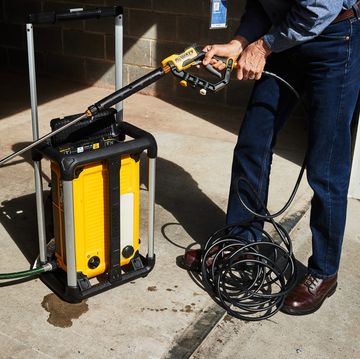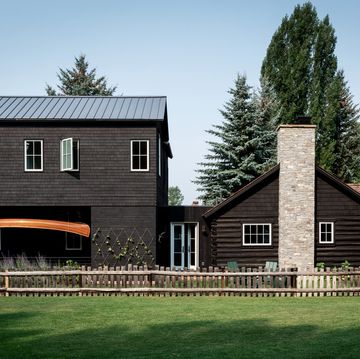1
How to Build a Simple Split-Rail Fence
 Media Platforms Design Team
Media Platforms Design Team
My simple ranch-style home was in desperate need of discipline. While my neighbors' property lines were neatly set off by picket fences and boxwood shrubs, mine lacked physical boundaries and seemed exposed, vulnerable—even unruly. With no fence, my expansive front lawn was edging its way onto the street, making itself irresistible to wayward dogs and parking cars.
The solution was to install a modest fence that would help contain my home while also giving it curb appeal. A split-rail seemed a good choice. It wouldn't obscure my one-story home but would provide it with a simple border along which I could plant shrubs. And I could festoon it with seasonal decorations.
I'll admit I'd never installed a fence before. But with careful planning and help from a few PopMech staffers, together we turned a seemingly daunting project into something manageable. The biggest challenge was digging the postholes—especially when we hit tough, gnarly tree roots—but as a team we finished the project in a weekend. It was well worth the effort: My new fence has brought much-needed order to my property, which no longer looks like the rough kid on the block.
2
The Paper Trail
 Media Platforms Design Team
Media Platforms Design Team
We didn't want our fence to irk neighbors, damage utility lines, or elicit fines, so we took care of some necessary paperwork first. Though your situation may differ from mine, be sure to complete all administrative legwork before heading to the lumberyard.
Know your boundaries
Begin by researching your town's zoning laws. Once you understand local restrictions and ordinances, such as setbacks from your property lines and appropriate fence heights, you can decide where your fence will sit and how it will look.
Survey the situation
To ensure that your fence doesn't encroach on your neighbor's yard, and to check for public easements, study your property survey. You can often find it among your home's closing paperwork. We didn't have ours, so we asked the attorney who handled our home's sale for a copy.
Start sketching
Figure out where you want the fence and draw its location on a copy of the property survey. You can then calculate how much material you will need. We bought enough for 110 feet of fence, which cost us $425.
Know what's below
A ruptured gas line will ruin your day, so call 811 before digging. This connects you to a nonprofit organization that sends utility companies to your property to mark the locations of underground pipes and cables with color-coded flags. But first stake out your proposed fence with white flags so they know where to start.
Get the go-ahead
We had to file a fence permit with our building department, which also required us to pay a small fee and include a sketch of the project.
3
Establish Outline
 Media Platforms Design Team
Media Platforms Design Team
Drive stakes into the ground a few feet past each corner or end post, and connect them with mason's string tied 12 inches above grade. We wanted the fence to run parallel to the sides of the house, so we measured out from the walls in a few places to keep the spacing consistent.
To check that each corner was square, I followed the Pythagorean theorem, or the 3-4-5 rule, as it’s more commonly known among carpenters. I attached a piece of painter’s tape along one string axis at 3 feet from the corner, and another along the other axis at 4 feet. I then measured 5 feet diagonally from tape to tape, confirming that the corner was 90 degrees.
Advertisement - Continue Reading Below
4
Mark Post Locations
 Media Platforms Design Team
Media Platforms Design Team
Working out from a corner, lay rails along the perimeter, overlapping their ends by 6 inches. This is where you'll dig holes for the line posts. Mark these locations on the ground with spray paint.
5
Set Rail Height
 Media Platforms Design Team
Media Platforms Design Team
Mark each post at 36 inches from its bottom end. This measurement takes the depth of the post's hole—24 inches—and adds the 12-inch-high string line. When you set the posts in the ground, you'll use this reference point to help establish the correct height of the rails.
6
Start Digging
 Media Platforms Design Team
Media Platforms Design Team
Many fence installers in my town prefer not to dig holes with powered augers, which can get dangerously stuck in the rocky soil. Instead, they use posthole diggers. Grasp the two handles together with both hands before thrusting the blades into the ground.
Advertisement - Continue Reading Below
7
Go Deep (or Not)
 Media Platforms Design Team
Media Platforms Design Team
Dig holes about 24 inches deep and 10 inches in diameter. The most important measurement, though, is from the bottom of the hole to the string, which should be 36 inches. Use a dig-and-tamp bar to shift any rocks or to grind through stubborn roots. We hit a rock that wouldn't shift, so we had to cut 6 inches off the post. That's fine, but removing more than that would have destabilized the post.
8
Set Posts
 Media Platforms Design Team
Media Platforms Design Team
Place posts upright into each hole, making sure the reference mark aligns with the string line. You may need to either dig deeper or backfill the holes with rocks. Once the post is where you want it, start filling the holes. Check that the posts are plumb by using a level or eyeballing the post against the corners of your house. Once you've filled the hole, tamp down the area around the base of the post, and then soak it to compact the soil. We repaired our scarred landscape by planting grass seed.
9
Install Rails
 Media Platforms Design Team
Media Platforms Design Team
Slide each rail through the slot far enough so that you can then back it into the slot on the opposite post.
Advertisement - Continue Reading Below
10
Finish the Job
 Media Platforms Design Team
Media Platforms Design Team
With a section of the fence installed, all that remained was to reseed the damaged lawn and apply a protective finish. Even though our fence parts had been pretreated with a wood preservative, we applied a clear exterior-grade stain to give it a finished look.
Advertisement - Continue Reading Below
Advertisement - Continue Reading Below
Advertisement - Continue Reading Below














